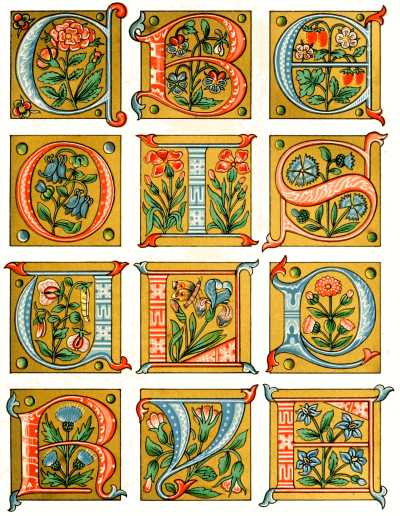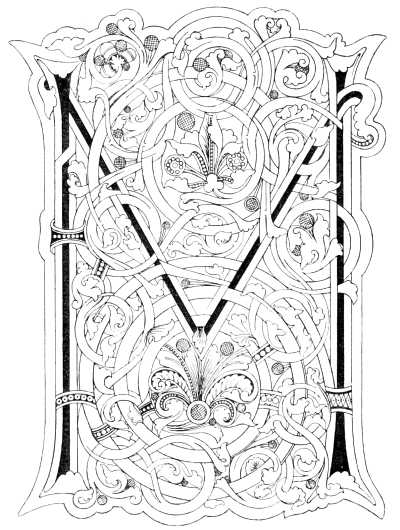

Left: Plate II. Initial Letters from French Manuscript, 15th Century. Right: Large Initial Letter from Harleian MSS. 3045, British Museum. from Lessons in the Art of Illuminating by W. J. Loftie. Source: Project Gutenberg EBook #40423 produced by Chris Curnow, Matthew Wheaton and the Online Distributed Proofreading Team. [Click on images to enlarge them.]
Description of Plate II

xecuted in the fifteenth century, probably in the north of France, the small manuscript from which the twelve initial letters are taken is in a private collection. It consists of twenty-four leaves of rather stout vellum, measuring 4-3/8 inches by 3 inches, and has evidently been a sampler or pattern book for a school of illumination. It contains two alphabets. The letters in the plate are selected from one of them. Outlines of the rest of this alphabet are on the back of Plate I. In copying them for color the student will remember that those letters which contain blue flowers are red, and vice versâ. Each letter is painted on a ground of leaf-gold highly burnished, and is ornamented with a natural flower. We may recognize the rose, the pansy, the strawberry, the columbine, the wall-flower, the corn-flower, the sweet pea, the iris, the daisy, the thistle, and others. Pinks, dog-roses, and forget-me-nots also occur, and the little volume forms, in this respect, a curious and interesting record of the produce of the flower garden so long ago as the time of the English "Wars of the Roses."
The second alphabet is of a wholly different character, the letters, not the ground on which they are placed, being gilt, and the ground colored red or blue. Over the red and the blue is a scroll pattern in white, but the red is sometimes decorated with a pattern in body-yellow, which produces an exceedingly gorgeous effect. In two or three cases the ground is green, worked over in a darker olive tint heightened with yellow. In one, a flower or scroll of grey is placed on a ground of blue dotted all over with minute gold spots.
The blue used in copying these initials for the plate was Prussian, mixed with Chinese White, and shaded with pure color. The green is a mixture of Indian Yellow and Prussian Blue. The pink is Lake and White shaded with pure Lake. The red terminals which appear in some of the letters are of Vermilion, shaded with Lake. Chinese White body color is largely used in working diapers over the letters of both colors.
These letters are good examples of the form chiefly in use for illuminated manuscripts and in ornamental sculpture all over northern Europe from the twelfth century to the sixteenth. They are generally called "the Lombardic character," from some real or fancied connection with Lombardy. Such names must be cautiously accepted. "Arabic numerals," for example, have been proved to be somewhat modified Greek letters. But the Lombardic capitals, whatever their origin, lend themselves readily to the exigencies of the illuminator, and are all the more effective from the contrast they present to the text.
It is now almost universally acknowledged that all the forms of the mediæval and modern alphabet may be traced to Egyptian hieroglyphics. A very interesting passage in Mr. Isaac Taylor's learned book on "The Alphabet," shows us the development of the letter M from the Egyptian picture of an owl. "It will be noticed," he says, "that our English letter has preserved, throughout its long history of six thousand years, certain features by which it may be recognized as the conventionalized picture of an owl. In the capital letter M the two peaks, which are the lineal descendants of the two ears of the owl, still retain between them a not inapt representation of the beak, while the first of the vertical strokes represents the breast." It would be easy to show the same ancient origin for many other letters, and for most of those in the Greek alphabet. F was a horned snake. G was a basket with a handle. K was a triangle. L was a lion seated. N was a zigzag line, of which only three strokes have survived. P was a faggot of papyrus. There is no perceptible difference between the long S still sometimes in use and the hieroglyphic form. U was a quail. Z was a serpent.
The initial E at the beginning of the previous page is of English work, and represents Edward the Black Prince receiving a charter from the hands of his father King Edward III. The prince places one knee on his helmet, and has on his head only the ornamental cap called a "bonnet." His arms and those of the king are colored on their respective "tabards."
The large letter M on the back of Plate II. is from a volume now in the British Museum (Harl. MSS. 3045), which was written in Germany in the twelfth century. It is illuminated in three colors. The ground is emerald green; the letter itself red; and the scroll-work also in red outline, a pale purple ground being substituted for the green in the circular spaces. It would be instructive to the student to color the outline from this description.
References
Beckwith, Alice H. R. H. Victorian Bibliomania: The Illuminated Book in Nineteenth-Century Britain. Exhibition catalogue. Providence. Rhode Island: Museum of Art, Rhode Island School of Design, 1987.
Loftie, W. J. . Lessons in the Art of Illuminating: A Series of Examples selected from Works in the British Museum, Lambeth Palace Library, and the South Kensington Museum.. London: London: Blackie & Son, nd. “The Colored Illustrations are Printed by W. G. Blackie & Co., Glasgow, from Drawings by J. A. Burt.” Project Gutenberg EBook #40423 produced by Chris Curnow, Matthew Wheaton and the Online Distributed Proofreading Team. Web. 11 January 2014.
Last modified 11 January 2014